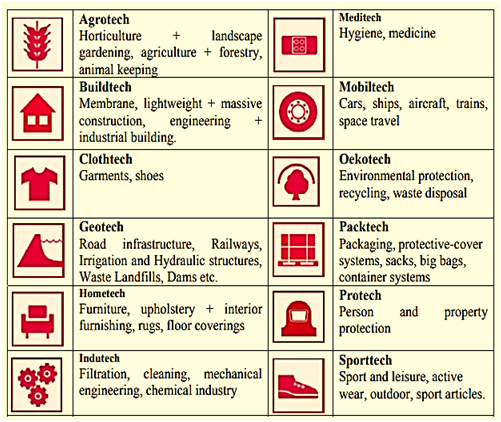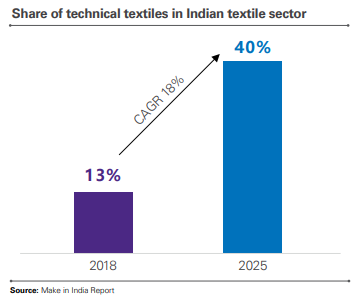National Technical Textiles Mission
- 29 Feb 2020
- On 26th February, 2020, the Cabinet Committee on Economic Affairs gave its approval to set up a National Technical Textiles Mission.
- The Mission would have a four year implementation period from FY 2020-21 to 2023-24.
Aim
- To promote research, export and skill development
- Encourage manufacturing facilities and use of Technical Textiles
- Reduce Technical Textiles imports of India
Need for the Mission
- Low Penetration Level: The penetration level of technical textiles is low in India, varying between 5-10% against the level of 30-70% in developed countries.
- Insignificant Share in World Market: Indian technical textiles segment is estimated at $16 billion which is approximately 6% of the $250 billion global technical textiles market.
Salient Features
The Mission will have four components:
Component One
- Focus will on Research, Innovation and Development.
- This component will promote both (i) fundamental research at fibre level aiming at path breaking technological products in Carbon Fibre, Aramid Fibre, Nylon Fibre, and Composites and (ii) application based research in geo-textiles, agro-textiles, medical textiles, mobile textiles and sports textiles and development of biodegradable technical textiles.
Component Two
- Focus will be on Promotion and Market Development.
- It will aim at average growth rate of 15-20% per annum taking the level of domestic market size to 40-50 Billion USD by the year 2024; through market development, market promotion, international technical collaborations, investment promotions and 'Make in India’ initiatives.
Component Three
- Focus will be on Export Promotion
- It aims at export promotion of technical textiles enhancing from the current annual value of approximately Rs.14000 Crore to Rs.20000 Crore by 2021-22 and ensuring 10% average growth in exports per year upto 2023-24.
- An Export Promotion Council for Technical Textiles will be set up for effective coordination and promotion activities in the segment.
Component Four
- Focus will be on Education, Training and Skill Development
- It will promote technical education at higher engineering and technology levels related to technical textiles and its application areas covering engineering, medical, agriculture, aquaculture and dairy segments.
- Skill development will be promoted and adequate pool of highly skilled manpower resources will be created for meeting the need of relatively sophisticated technical textiles manufacturing units.
Subcomponent
- A sub-component of the research will focus on development of bio degradable technical textiles materials, particularly for agro-textiles, geo-textiles and medical textiles. It will also develop suitable equipment for environmentally sustainable disposal of used technical textiles, with emphasis on safe disposal of medical and hygiene wastes.
- There is another important sub-component in the research activity aiming at development of indigenous machineries and process equipment for technical textiles.
Significance
- Making Self-Reliant: The step would position the country as a global leader in technical textiles,making self-dependent in technical textile sector and to nullify the burden of technical textiles segment on India’s trade deficit within the next one year.
- Holistic Growth and Development:The use of technical textiles in agriculture, aquaculture, dairy, poultry, JalJivan Mission, Swachch Bharat Mission, Ayushman Bharat will bring an overall improvement in cost economy, water and soil conservation, better agricultural productivity and higher income to farmers per acre of land holding in addition to promotion of manufacturing and exports activities in India.
Technical Textile
- Technical textiles are textiles materials and products manufactured primarily for technical performance and functional properties rather than aesthetic characteristics.
- Technical Textiles products are divided into 12 broad categories - Agrotech, Buildtech, Clothtech, Geotech, Hometech, Indutech, Mobiltech, Meditech, Protech, Sportstech, Oekotech and Packtech.
Raw Material for Technical Textile
- Natural Fiber: Cotton, Silk, Sisal, Rax, Wool
- Man Made Fibers and Polymers: Viscose, PolyarTiide, Polyolefin, Flax, Polyester, Aramid, UMHW Polyethylene, Carbon, Glass
Applications
- Technical textiles have specialized applications in diverse areas such as production of fire-resistant vests, bulletproof jackets, high altitude combat gear, as well as space applications. They are also used in automobile and medical industries.

Indian Technical Textile Indusrty
- Technical textile industry in India is import dependent. Many products like specialityfibres/yarns, medical implants, sanitary products, protective textiles, webbings for seat belts, etc. are mostly imported.
- As per the Baseline Survey of technical textile industry by Ministry of Textiles, Indian technical textile industryis estimated to grow at a CAGR of 20 percent to INR2,00,823 crore by 2020-21 from INR1,16,217 crore in 2017-18.

Analysis of Indian Technical Textile Industry
Strengths
- Availability of Young and Cheap Manpower: India has one of the largest working-agepopulation (people between 15 and 64 yearsof age) in the world. Based on the country’scurrent demographics, the abundant workforce isexpected to work until 2055. Abundant workforcewith relatively lower average manpower costsprovides India a distinct edge as key globalmanufacturing destination.
- Strong Textiles Value Chain: India is the onlycountry in the region, other than China, with entiretextile value chain in both natural and syntheticfibres. Due to availability of raw materials fortechnical textiles sub-segments, India is wellpositioned to capitalize on opportunities presentedby both domestic and international markets.
- Active Promotion from Government: Government has been activelyworking towards development of technical textilesin India. For the purpose, Government of Indiahas launched several programs (for investmentpromotion, subsidies, creation of infrastructure,stimulating consumption etc.) such as Schemefor growth and development of technical textiles(SGDTT), Technology mission on technicaltextiles (TMTT), Scheme for promoting usageof Agro-textiles in north east region, Schemefor promoting usage of geotechnical textiles innorth east region, Technology up-gradation fundsscheme (TUFS) and Scheme for integrated textile parks (SITP).
- Availability of Manufacturing Infrastructure: India is a rapidly growing industrial economy withavailability of key resources such as land, power,water, manpower and conducive regulatoryframework for industries to thrive and grow.Technical textiles manufacturing set up can beestablished easily with an attractive and growingmarket to spur demand.
Weaknesses
- Import Dependence for Machinery Currently,majority of machinery used to manufacturetechnical textiles products is not available in India.In order to attract investments in technical textiles,Government needs to promote manufacturing ofhigh-tech machinery to boost technical textilessector.
- Low Awareness about Technical Textile Products in End Users: In India, majority ofintended end users of technical textile productsare still unaware of the benefits of usage of suchproducts, thereby leading to lack of adoption.
- Lack of Standardization and Related Regulations: Currently, several technical textile products do nothave Standard Benchmarks, resulting in availabilityof sub-standard cheaper products. Further, safetyand other related regulations need to be enforcedacross industries to propel demand for technicaltextiles products.
- Little or No Domestic Manufacturing of Specialty Fibres: Currently, majority of specialtyfibres are imported in India, thus making India globally uncompetitive in high-value technical textiles products.
Suggestive Measures
- Raising awareness of end-use applications
- Regulatory reforms supporting the usage of standardised technical textile products
- Development and implementation of standards
- for technical textile products
- Incentivisingresearch and development in the field of technical textiles
- Dedicated courses on technical textiles for entrepreneurship training
- Improving availability of skilled manpower
- Promoting indigenous manufacturing of high performance specialty fibres
- Promoting institutional buying
- Incentivising production of technical textiles machinery
- Promotion of exports of technology intensive technical textiles
Way Forward
- The future of the technical textile industry in India has a positive outlook and is mirrored by increasingly strong consumption rates in the domestic market as well as the growing demand for exports.
- With the appropriate measures, the industry has potential to emerge as a global hub for technical textile manufacturingas well as to contributesignificantly to the government’s vision to become a USD 5 trillion economyin the next few years.




